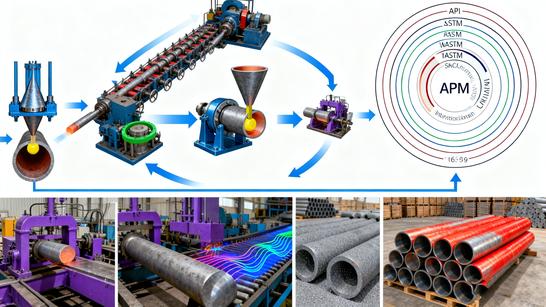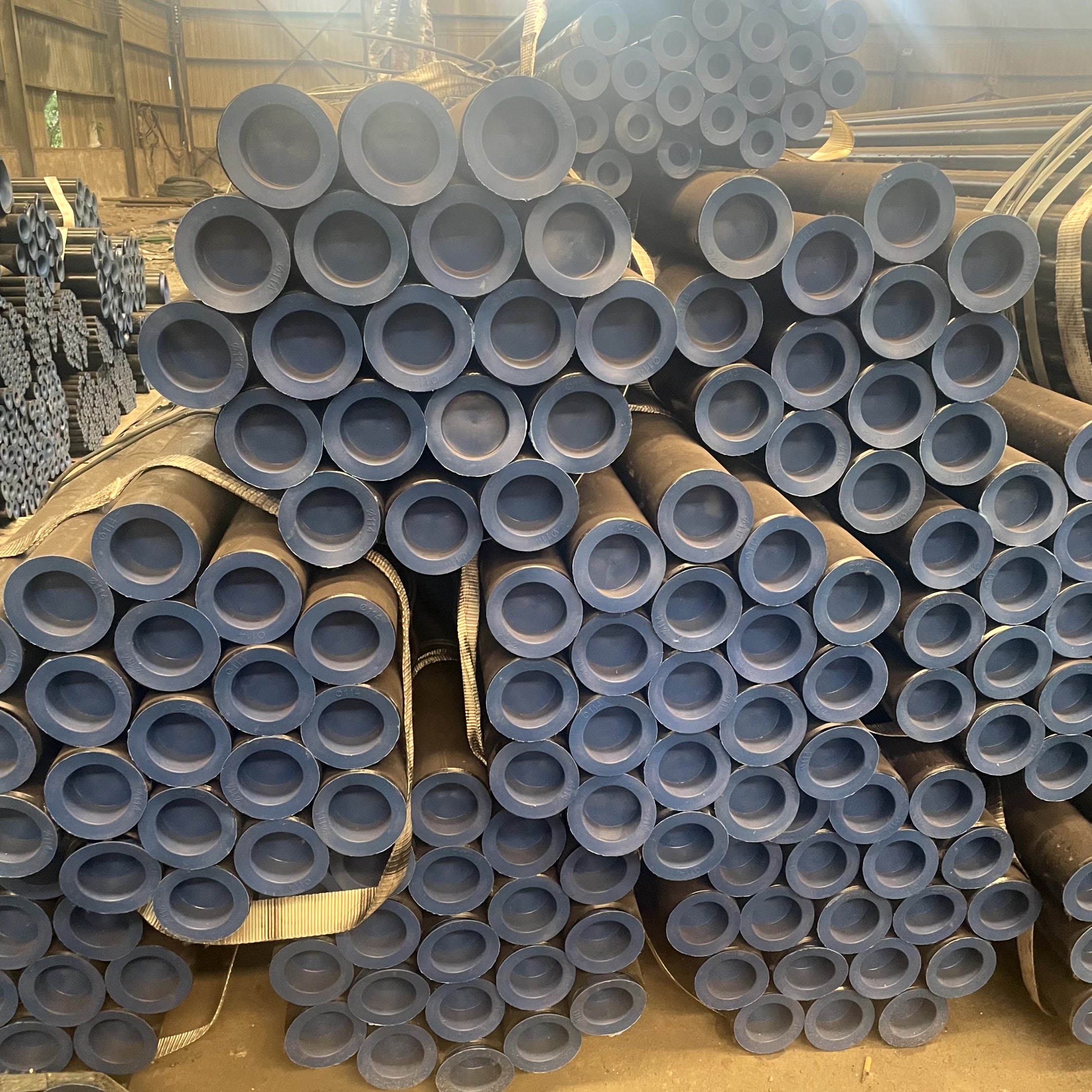In industries demanding exceptional corrosion resistance, high-temperature stability, and compliance with strict European regulations—such as chemical processing, marine engineering, food production, and pharmaceuticals—European standard stainless steel tubes have become the gold standard for reliability. Among these, EN 10216-5 seamless tubes, 1.4404 stainless steel pipes (equivalent to 316L), 316L seamless stainless tubes, European standard stainless steel tubes, and corrosion-resistant stainless steel pipes stand out for their adherence to the rigorous EN 10216-5 specification, ensuring consistent performance across critical applications. This guide systematically deciphers their definitions, technical standards, selection criteria, real-world applications, and maintenance best practices, while highlighting the unique value of EN 10216-5 stainless steel tubing for global projects. It serves as a practical resource for engineers, procurement managers, and quality assurance teams seeking to navigate European standard stainless steel solutions.
1. Core Definitions: Unpacking European Standard Stainless Steel Tube Variants
Each type of European standard stainless steel tube is engineered to address specific industrial challenges, with distinct material compositions, manufacturing processes, and performance attributes. Clarifying these definitions is essential for accurate application and compliance.
1.1 EN 10216-5 Seamless Tube
EN 10216-5 seamless tubes are defined by the European standard EN 10216-5, which governs "Seamless steel tubes for pressure purposes — Part 5: Stainless steel tubes." Their key characteristics include:
- Scope: Designed for pressure-bearing applications (e.g., chemical reactors, heat exchangers) where corrosion resistance and structural integrity are critical.
- Material Grades: Covers austenitic, ferritic, and martensitic stainless steels, with austenitic grades (e.g., 1.4404/316L, 1.4301/304) being the most widely used for general corrosion-resistant needs.
- Manufacturing: Produced via hot piercing followed by cold drawing/rolling, eliminating weld seams that pose risks of corrosion or failure under pressure.
- Quality Assurance: Mandatory compliance with strict dimensional tolerances, mechanical property testing, and non-destructive testing (NDT) as specified in the standard.
1.2 1.4404 Stainless Steel Pipe
1.4404 stainless steel pipes are a premium austenitic stainless steel grade under European Norm (EN) standards, directly equivalent to the global 316L grade. Their defining features include:
- Chemical Composition: Contains 16–18% chromium (Cr), 10–14% nickel (Ni), and 2–3% molybdenum (Mo), with a carbon content ≤0.03% (the "L" in 316L denotes low carbon).
- Corrosion Resistance: Molybdenum addition provides superior resistance to pitting, crevice corrosion, and chloride-induced stress corrosion cracking—making it ideal for marine, coastal, and chemical environments.
- Mechanical Properties: Tensile strength ≥480 MPa, yield strength ≥170 MPa, and elongation ≥40%, ensuring excellent ductility for forming, bending, and welding.
1.3 316L Seamless Stainless Tube
316L seamless stainless tubes are the global counterpart to 1.4404 stainless steel pipes, with identical chemical composition and performance. The key distinction lies in regional nomenclature:
- Nomenclature: "316L" is the common designation in North America (per ASTM standards), while "1.4404" is used in Europe (per EN standards).
- Application Alignment: Both grades are interchangeable in most global projects, though EN 10216-5 specifies additional testing requirements (e.g., intergranular corrosion testing) for 1.4404 tubes.
1.4 European Standard Stainless Steel Tube
European standard stainless steel tubes encompass all stainless steel tubes compliant with EN standards (e.g., EN 10216-5 for pressure purposes, EN 10312 for water supply). They differ from non-European standards (e.g., ASTM, JIS) in:
- Regulatory Compliance: Aligned with European Union (EU) directives such as REACH (chemical safety) and CE marking (product safety), ensuring market access within the EU and beyond.
- Testing Rigor: Emphasize specialized tests like the Strauss test (for intergranular corrosion) and burst pressure testing (for pressure integrity), exceeding the requirements of some international standards.
- Dimensional Precision: Tighter tolerances for outer diameter (OD ±0.3mm for small tubes) and wall thickness (WT ±10%) compared to ASTM counterparts, reducing assembly gaps in precision equipment.
1.5 Corrosion-Resistant Stainless Steel Pipe
Corrosion-resistant stainless steel pipes are a broad category that includes EN 10216-5 seamless tubes and 1.4404/316L pipes. Their primary value lies in:
- Environmental Adaptability: Resist corrosion from aggressive media such as seawater, acidic solutions (pH 2–12), and industrial gases (e.g., chlorine, sulfur dioxide).
- Longevity: Service life of 20–30 years in harsh environments, compared to 5–10 years for carbon steel pipes (even with coatings).
- Low Maintenance: Eliminate the need for frequent repainting or cathodic protection, reducing lifecycle costs.
1.6 EN 10216-5 Stainless Steel Tubing
EN 10216-5 stainless steel tubing is a specific subset of EN 10216-5 seamless tubes, often referring to smaller-diameter (OD ≤50mm) options used in precision applications (e.g., pharmaceutical fluid lines, instrument tubing). It retains all EN 10216-5 requirements while offering enhanced surface finish options (e.g., bright annealing for hygiene applications).
2. Key Technical Standards: EN 10216-5 and Compliance Requirements
EN 10216-5 is the cornerstone standard for European pressure-grade stainless steel seamless tubes, setting strict benchmarks for material quality, performance, and testing. Below is a detailed breakdown of its core requirements and related standards.
2.1 EN 10216-5: The Definitive Standard for Pressure-Grade Stainless Steel Tubes
EN 10216-5 outlines mandatory requirements for stainless steel seamless tubes used in pressure systems, including:
- Material Grades & Chemical Composition:
- Austenitic grades: 1.4301 (304), 1.4401 (316), 1.4404 (316L) — with strict limits on harmful elements (e.g., sulfur ≤0.015% for 1.4404 to prevent hot cracking).
- Ferritic grades: 1.4003 (430) — used for low-pressure, non-corrosive applications.
- Martensitic grades: 1.4125 (440C) — for high-strength, low-corrosion scenarios (e.g., valves).
- Mechanical Testing:
- Tensile and yield strength testing per EN ISO 6892-1.
- Impact testing at -196°C (for cryogenic applications) or 20°C (for ambient use) per EN ISO 148-1.
- Hardness testing (Brinell or Vickers) to ensure material ductility (e.g., ≤210 HB for 1.4404).
- Non-Destructive Testing (NDT):
- 100% eddy current testing (ECT) for surface defects (per EN 10246-3).
- 100% ultrasonic testing (UT) for internal defects (per EN 10246-4) for tubes with WT >6mm.
- Hydrostatic pressure testing at 1.5× design pressure (minimum 30-second hold) to verify leak tightness.
- Surface Finish:
- Pickled finish (Ra ≤6.3μm): Standard for industrial applications, removing scale and oxide layers.
- Bright annealed finish (Ra ≤0.8μm): Required for hygiene-sensitive sectors (food, pharmaceuticals) to prevent bacterial adhesion.
2.2 Related European Standards for Compatibility
To ensure system-wide compliance, EN 10216-5 tubes must be paired with fittings and components that meet complementary EN standards:
- Fittings: EN 10253-4 (stainless steel butt-weld fittings) — ensures dimensional matching and corrosion resistance.
- Flanges: EN 1092-1 (flanges for pressure equipment) — specifies flange dimensions, pressure ratings, and material compatibility with EN 10216-5 tubes.
- Welding: EN ISO 15614-1 (welding procedure qualification) — defines acceptable welding methods (e.g., TIG, MIG) for EN 10216-5 tubes to avoid post-weld corrosion.
3. Selection Guide: Choosing the Right EN 10216-5 Tube for Your Application
Selecting the optimal European standard stainless steel tube requires a data-driven approach, balancing application requirements, material performance, and regulatory compliance. Follow these four steps for success:
3.1 Analyze Application Conditions
- Corrosion Environment:
- Chloride-rich environments (seawater, coastal areas): Prioritize 1.4404 (316L) EN 10216-5 tubes — molybdenum resists pitting corrosion (critical for marine pipelines).
- Weak acids/bases (food processing, cleaning solutions): 1.4301 (304) EN 10216-5 tubes offer cost-effective corrosion resistance.
- Strong acids (sulfuric, nitric acid): Upgrade to super duplex stainless steel (e.g., 1.4462) EN 10216-5 tubes for enhanced resistance.
- Pressure & Temperature:
- Low pressure (<10 bar, ≤100°C): 1.4301 EN 10216-5 tubes with thin walls (e.g., Sch 10) — cost-efficient for non-critical systems.
- High pressure (10–100 bar, 200–400°C): 1.4404 EN 10216-5 tubes with thick walls (e.g., Sch 80) — low carbon content prevents intergranular corrosion at elevated temperatures.
- Cryogenic conditions (<-50°C, LNG transport): 1.4404 EN 10216-5 tubes — austenitic structure avoids brittle fracture.
- Hygiene & Regulatory Requirements:
- Food/pharmaceuticals: 1.4404 EN 10216-5 tubes with bright annealed finish (Ra ≤0.4μm) — compliant with EU Regulation (EC) No. 1935/2004 (food contact materials).
- Medical devices: 1.4404 EN 10216-5 tubes with electropolished finish (Ra ≤0.2μm) — meets ISO 10993 (biocompatibility).
3.2 Verify Material & Standard Compliance
- Grade Confirmation: Ensure the tube grade aligns with corrosion and temperature needs (e.g., 1.4404, not 1.4301, for seawater applications — 1.4301 lacks molybdenum and will pit within 1–2 years).
- EN 10216-5 Compliance: Request a "Certificate of Compliance" (CoC) from the manufacturer, verifying adherence to EN 10216-5’s chemical, mechanical, and NDT requirements.
- CE Marking: Confirm the tube bears the CE mark (per EU Pressure Equipment Directive, PED 2014/68/EU) — mandatory for pressure applications in the EU and most global markets.
3.3 Evaluate Dimensional & Surface Requirements
- Dimensional Tolerances:
- Precision applications (instrumentation): EN 10216-5 tubes with class 1 tolerance (OD ±0.1mm, WT ±5%) — ensures compatibility with small-bore fittings.
- General industrial use: Class 2 tolerance (OD ±0.3mm, WT ±10%) — balances precision and cost.
- Surface Finish:
- Industrial pipelines: Pickled finish — cost-effective and easy to paint (if additional protection is needed).
- Hygiene sectors: Bright annealed or electropolished finish — eliminates crevices where bacteria or product residue can accumulate.
3.4 Compare Cost & Lifecycle Value
- Upfront vs. Long-Term Costs: 1.4404 (316L) EN 10216-5 tubes cost 30–50% more than 1.4301 (304) tubes upfront, but in chloride environments, their 3× longer service life (25 years vs. 8 years) reduces total ownership cost by 40%.
- Avoid Over-Specification: For low-corrosion, ambient-temperature applications (e.g., indoor water lines), 1.4301 EN 10216-5 tubes offer sufficient performance without unnecessary expense.
4. Application Cases: EN 10216-5 Tubes in Critical Industries
4.1 Chemical Processing
- Project: A German chemical plant’s hydrochloric acid (HCl) transfer pipeline.
- Solution: EN 10216-5 seamless tubes (grade 1.4404/316L, OD 89mm, WT 6mm) with pickled finish, paired with EN 10253-4 butt-weld fittings.
- Rationale: 1.4404’s molybdenum content resists HCl-induced pitting; EN 10216-5’s UT/ECT testing ensures no internal defects that could leak corrosive media.
- Result: Zero corrosion or leaks after 7 years of operation, complying with EU REACH regulations.
4.2 Marine Engineering
- Project: A Dutch offshore wind farm’s seawater cooling system.
- Solution: EN 10216-5 stainless steel tubing (grade 1.4404/316L, OD 32mm, WT 4mm) with bright annealed finish, installed with EN 1092-1 flanges.
- Rationale: 1.4404 resists seawater chloride corrosion; bright annealed finish prevents marine biofouling (e.g., barnacle growth) that clogs pipes.
- Result: Reduced maintenance frequency by 60% compared to carbon steel pipes (previously replaced every 3 years).
4.3 Food & Beverage Production
- Project: An Italian dairy’s milk processing pipeline.
- Solution: EN 10216-5 seamless tubes (grade 1.4404/316L, OD 50mm, WT 3mm) with electropolished finish, connected via EN 10253-4 sanitary fittings.
- Rationale: Electropolished finish (Ra ≤0.2μm) eliminates bacterial hiding spots; 1.4404 is compliant with EU 1935/2004 (food contact safety).
- Result: Passed annual EU food safety audits, with no product contamination incidents.
4.4 Pharmaceutical Manufacturing
- Project: A Swiss pharmaceutical plant’s sterile drug solution pipeline.
- Solution: EN 10216-5 stainless steel tubing (grade 1.4404/316L, OD 25mm, WT 2.5mm) with electropolished finish, welded via EN ISO 15614-1 TIG procedures.
- Rationale: Electropolished surface meets ISO 10993 biocompatibility; EN 10216-5’s hydrostatic testing ensures sterility (no leakage of sterile media).
- Result: Compliant with EU Good Manufacturing Practice (GMP) standards, supporting the production of injectable drugs.
5. Quality Control & Maintenance Best Practices
5.1 Manufacturing Quality Assurance
- Raw Material Sourcing: Use stainless steel billets from EN 10088-1 certified mills (e.g., Outokumpu, Thyssenkrupp) — ensures chemical composition matches EN 10216-5 requirements.
- Seamless Production Control:
- Hot piercing: Maintain temperature at 1200–1250°C for 1.4404 to avoid grain coarsening (which reduces corrosion resistance).
- Cold drawing: Use multi-pass drawing with lubrication (food-grade for hygiene applications) to achieve tight dimensional tolerances.
- Heat Treatment: For 1.4404 tubes, perform solution annealing at 1050–1100°C followed by rapid water cooling — dissolves chromium carbides and restores corrosion resistance.
5.2 Installation Best Practices
- Welding:
- Use TIG welding with argon back purging (99.99% pure argon) to prevent oxidation of the weld root (oxidation causes post-weld corrosion).
- Qualify welders to EN ISO 9606-1 (stainless steel welding certification) — ensures weld quality meets EN 10216-5 standards.
- Cleaning & Passivation:
- After installation, clean tubes with a 5–10% nitric acid solution (per EN ISO 3887) to remove oil, grease, and welding slag.
- Perform passivation to rebuild the chromium oxide film — critical for restoring corrosion resistance damaged during welding.
- Pressure Testing: Conduct hydrostatic testing at 1.5× design pressure (per EN 10216-5) for 30 minutes — document results in a test report for compliance audits.
5.3 Post-Operation Maintenance
- Routine Inspection:
- Monthly: Visual inspection for surface rust, leaks, or biofouling (especially in marine applications).
- Annually: Ultrasonic thickness testing — replace tubes if wall thickness decreases by >20% (indicates excessive corrosion).
- Corrosion Prevention:
- For outdoor tubes: Apply a UV-resistant coating (per EN 10204) to prevent environmental degradation.
- For food/pharmaceutical tubes: Use alkaline cleaners (per EN 1276) — avoid acidic cleaners that damage the passivation film.
- Repair Guidelines:
- Small surface scratches (≤0.1mm depth): Polish with 320-grit sandpaper followed by passivation.
- Leaks or deep defects: Replace the affected tube section (no patching allowed for pressure or hygiene applications).
6. Future Trends: Innovations in EN 10216-5 and Corrosion-Resistant Tubes
6.1 Material Innovation
- Low-Molybdenum 316L Alternatives: Development of grades like 1.4404-M (reduced molybdenum to 1.5–2.0%) — maintains 90% of 1.4404’s corrosion resistance while lowering costs by 15%.
- Super Austenitic Stainless Steels: Introduction of EN 10216-5-compliant 1.4547 (904L) tubes — contains 23% chromium and 4.5% molybdenum, offering 5× better corrosion resistance than 1.4404 for ultra-harsh environments (e.g., acidic oilfields).
6.2 Sustainable Manufacturing
- Green Steel Production: Adoption of hydrogen-based direct reduction (HDR) for stainless steel billets — reduces carbon emissions by 70% compared to traditional blast furnaces, aligning with EU Green Deal goals.
- Recyclability: EN 10216-5 tubes are 100% recyclable, with recycled stainless steel retaining 99% of original properties — manufacturers are increasing recycled content to 50% (up from 30% in 2020).
6.3 Smart Tube Technology
- Sensor-Embedded Tubes: Integration of fiber optic sensors into EN 10216-5 tubes — real-time monitoring of wall thickness, temperature, and corrosion, enabling predictive maintenance (reduces unplanned downtime by 30%).
- Digital Twins: Creation of virtual replicas of EN 10216-5 tube systems — simulates fluid flow, pressure drops, and corrosion rates to optimize design and maintenance schedules.
6.4 Enhanced Surface Treatments
- Nano-Coatings: Application of titanium nitride (TiN) nano-coatings to EN 10216-5 tubes — improves wear resistance by 40% and reduces biofouling in marine applications.
- Advanced Passivation: Use of citric acid passivation (instead of nitric acid) — safer for operators, environmentally friendly, and achieves a more uniform passivation film (enhances corrosion resistance by 15%).
Conclusion
EN 10216-5 seamless tubes, 1.4404 (316L) stainless steel pipes, and European standard corrosion-resistant tubes represent the pinnacle of reliability for industries where failure is not an option. Their adherence to EN 10216-5’s strict standards ensures consistent performance, regulatory compliance, and long-term durability across corrosive, high-pressure, and hygiene-sensitive applications. By understanding their definitions, mastering selection criteria, and implementing rigorous quality control and maintenance practices, organizations can unlock the full value of these solutions—reducing costs, minimizing risk, and meeting global European regulatory requirements. As the industry evolves toward sustainability and smart technology, staying updated on innovations in EN 10216-5 materials and manufacturing will be key to maintaining a competitive edge. For customized solutions (e.g., ultra-large diameter EN 10216-5 tubes, cryogenic 1.4404 tubes), partner with EN-certified manufacturers to ensure alignment with your project’s unique needs.





